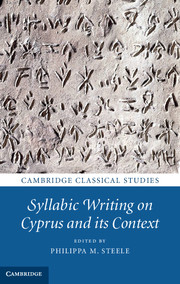
- Cited by 6
-
Cited byCrossref Citations
This Book has been cited by the following publications. This list is generated based on data provided by Crossref.
Iacovou, Maria 2013. Historically Elusive and Internally Fragile Island Polities: The Intricacies of Cyprus's Political Geography in the Iron Age. Bulletin of the American Schools of Oriental Research, Vol. 370, Issue. , p. 15.
2014. Books Received. The Classical Review, Vol. 64, Issue. 1, p. 313.
2014. Books Received. Classical Philology, Vol. 109, Issue. 1, p. 94.
Iacovou , Maria 2019. Philippa M. Steele. 2019. Writing and Society in Ancient Cyprus. Journal of Greek Archaeology, Vol. 4, Issue. , p. 443.
Kearns, Catherine and Georgiadou, Anna 2021. Rural Complexities: Comparative Investigations at Small Iron Age Sites in South-Central Cyprus. Journal of Field Archaeology, Vol. 46, Issue. 7, p. 461.
Pestarino, Beatrice 2025. “I see wonderful things!” Socio-cognitive experience of Cypriot graffiti in ancient Egypt. Journal of Ancient History,
- Publisher:
- Cambridge University Press
- Online publication date:
- March 2013
- Print publication year:
- 2013
- Online ISBN:
- 9781139208482


